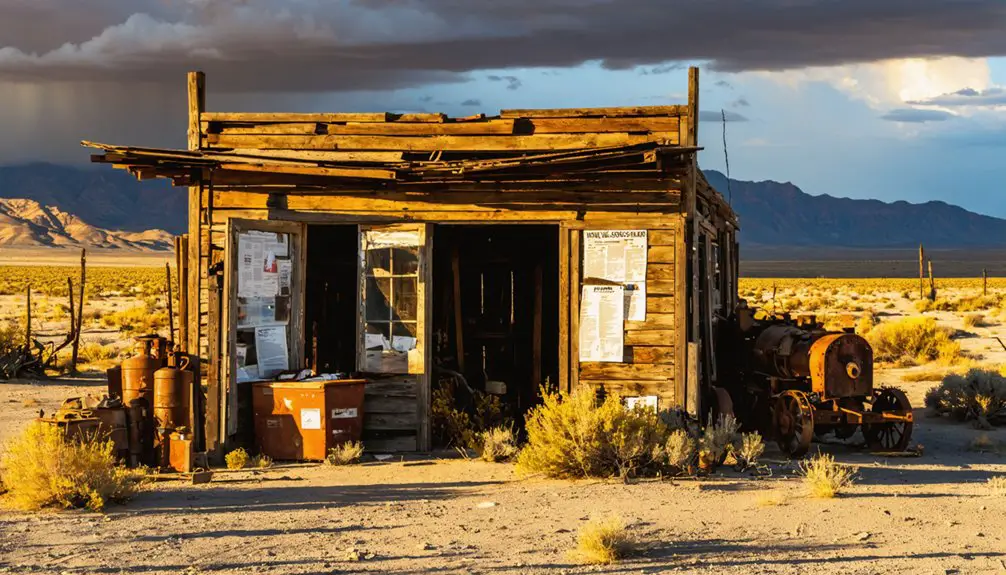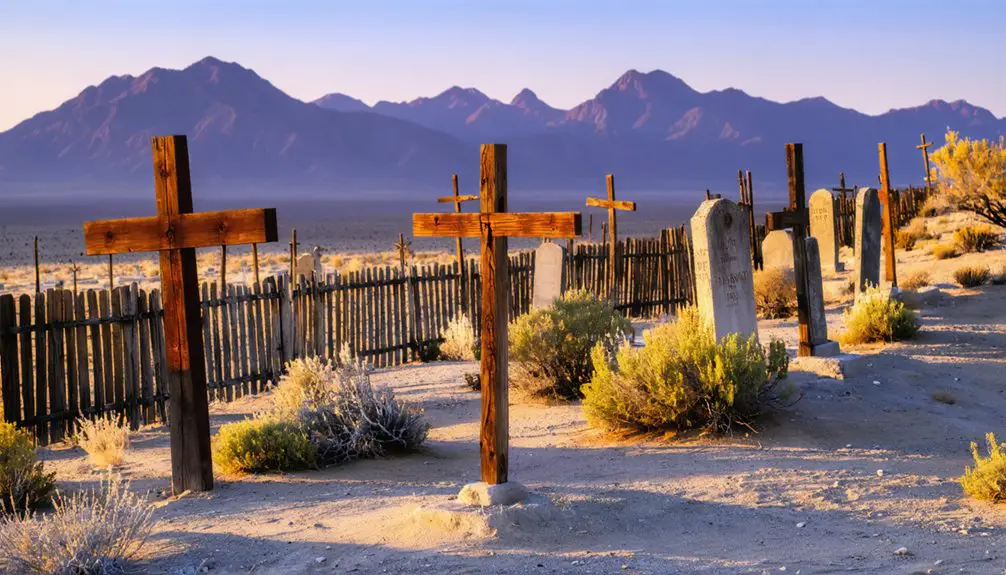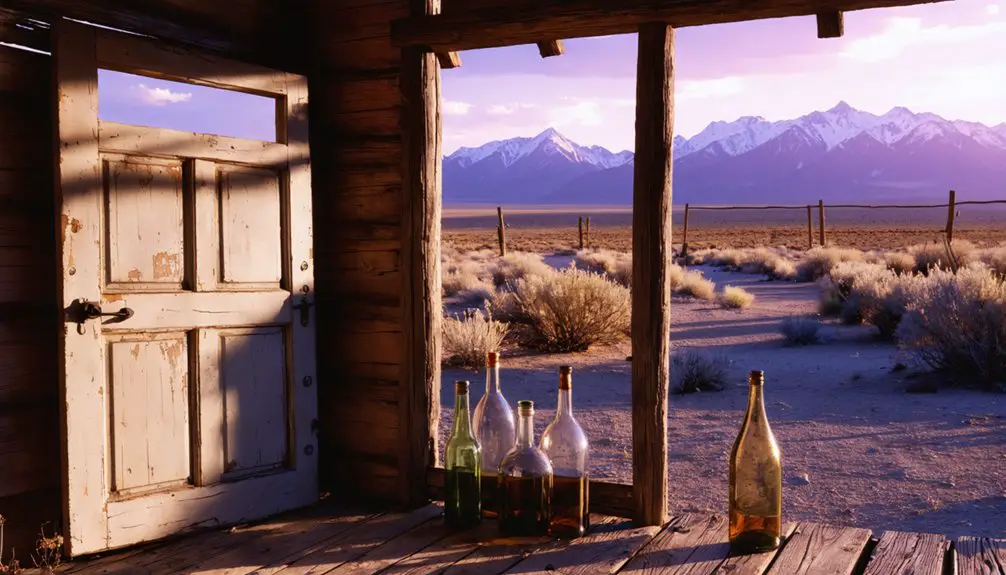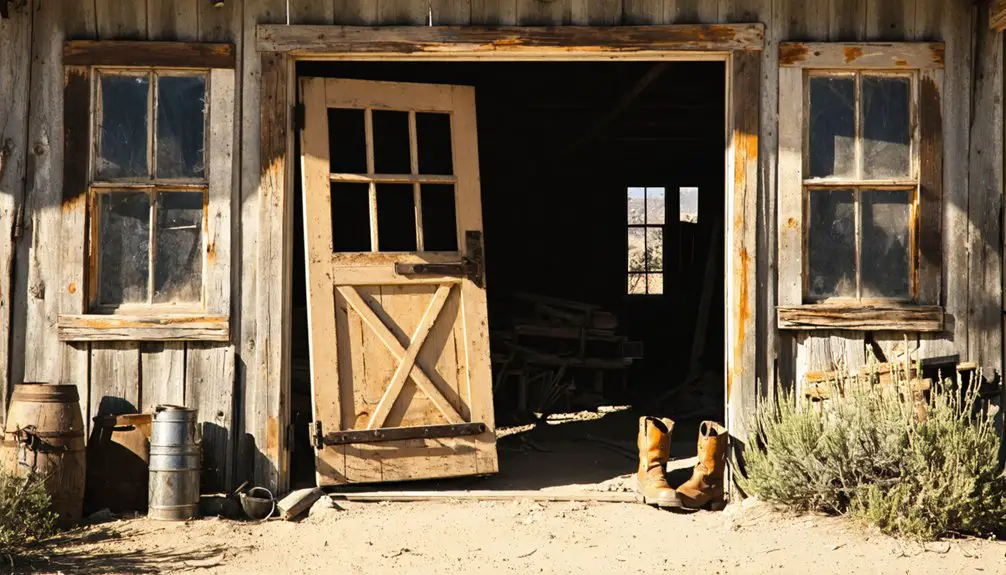You’ll find Tonopah nestled in Nevada’s high desert, where Jim Butler’s 1900 silver discovery transformed a simple spring into one of America’s richest mining districts. The boomtown quickly grew to 10,000 residents, with five banks and an opera house during its peak years of 1910-1914. Though major mining operations ceased by 1947, you can still explore its haunted Mizpah Hotel, historic cemetery, and preserved buildings that whisper tales of Nevada’s silver rush glory days.
Key Takeaways
- Tonopah transformed from a silver mining boomtown of 10,000 residents to a ghost town after major mines closed by 1947.
- The town’s Historic Cemetery contains 300 graves, including victims of the 1911 Belmont Mine fire and mysterious mining-related illnesses.
- Jim Butler’s 1900 silver discovery sparked Tonopah’s rise, with peak mining revenues exceeding $8 million annually between 1910-1914.
- The Mizpah Hotel, built in 1907, remains a preserved landmark featuring ghost stories and reported supernatural encounters.
- Despite its ghost town status, Tonopah preserves about 30% of its original cemetery headstones and historic mining-era structures.
The Discovery That Changed Everything
While prospecting near Tonopah Springs on May 19, 1900, Jim Butler’s wayward mule led him to a discovery that would transform Nevada’s economic future.
When he first had the silver ore assayed in Klondike, they dismissed it as worthless iron. But Butler’s instincts told him otherwise, and he kept samples on his ranch windowsill.
Tasker L. Oddie, who’d later become Nevada’s governor, believed in Butler’s discovery and funded a new assay. The results were staggering – up to $600 per ton.
Though initially delayed by his hay harvest, Butler returned with his wife Belle on August 25 to stake the first claims: Desert Queen, Burro, and Mizpah. By Christmas 1900, a small camp named Butler had grown to 14 residents.
Despite the pressing duties of harvest time, Jim Butler and Belle ventured back to stake their historic Nevada mining claims.
The town’s name originated from Shoshone native words meaning greasewood and water.
Butler’s discovery ended Nevada’s 20-year economic slump and sparked one of America’s richest silver booms, drawing thousands to this once-isolated region.
Rise of a Silver Empire
You’ll find that Tonopah’s silver discovery sparked an extraordinary economic transformation, with mine production reaching nearly $121 million in gold, silver, and copper between 1900 and 1921.
The city quickly evolved into a thriving metropolis by 1907, boasting five banks, multiple newspapers, hotels, and an opera house, with impressive brick and stone buildings up to five stories high dotting the business district. Jim Butler’s innovative 75% profit sharing system with miners helped drive this rapid development. The discovery was initially validated when early assays revealed values of up to $600 per ton of ore.
Your understanding of Tonopah’s rapid ascent deepens when you consider that during its peak years of 1910-1914, the district’s annual mining revenues exceeded $8 million, establishing it as one of the West’s most prosperous mining regions.
Silver Discovery Sparks Growth
On a fateful May morning in 1900, Jim Butler’s wandering mule led him to one of Nevada’s most significant silver discoveries near Tonopah Springs, a historic Native American campground.
You’ll find it fascinating that while a Klondike assayer initially dismissed Butler’s samples as worthless iron, Tasker Oddie’s belief in the ore led to a second assay revealing values up to $600 per ton. This discovery revolutionized mining techniques in the region, as Butler and his wife implemented innovative foot-lease arrangements that guaranteed miners 75% of their profits.
Today, the Tonopah Historic Mining Park stands as a testament to this remarkable discovery, allowing visitors to explore authentic mining structures and equipment.
The strike triggered Nevada’s economic revitalization, transforming Tonopah into the nation’s richest silver producer.
You can trace the boom’s impact through the establishment of railroads, processing mills, and a surge in population to 10,000 residents, making Tonopah the new county seat by 1905.
Thriving Mines Drive Prosperity
The silver empire of Tonopah reached staggering heights during its golden age from 1910 to 1914, when annual mine production topped $8 million.
Mining innovations and sophisticated corporate structures, led by the Philadelphia-based Tonopah Mining Company, transformed this remote desert outpost into one of the West’s premier mining cities.
You’d have found a bustling metropolis with five banks, grand hotels, and an opera house by 1907.
The district’s economic transformations were remarkable, generating nearly $121 million by 1921.
Steam-powered mills, private railways, and eastern capital investments kept the silver flowing.
By 1913, the area’s output reached an impressive $10 million in precious metals and minerals.
Even during the Great Depression, a clever leasing system helped maintain production.
The company’s formation in July 12, 1901 marked the beginning of large-scale mining operations in the region.
The Devastating Mine Fire of 1911
You’ll find few mining disasters more haunting than Tonopah’s Belmont Mine fire of 1911, where seventeen miners lost their lives after smoke from a small blaze near the 1,666-foot level spread through the shafts.
Cage operator “Big Bill” Murphy heroically saved several trapped miners before succumbing to the toxic fumes on his third rescue attempt, falling from his cage to join the others who couldn’t escape the deadly underground inferno. Today, a monument on Main Street commemorates Murphy and his fellow miners who perished that day. Emergency response teams worked tirelessly to contain the blaze and rescue survivors.
The tragedy, which began with a carelessly placed candle and ended in a blizzard-swept funeral procession, forever changed Tonopah’s mining community and left an indelible mark on Nevada’s mining history.
Deadly Underground Inferno Unfolds
Deep within the Belmont Mine near Tonopah, a devastating fire erupted on February 23, 1911, forever changing the mining community’s history.
You’ll find the tragedy began when a carelessly placed candle ignited timber stacks at 1,666 feet below ground, exposing critical flaws in mine safety and fire prevention protocols. The blaze, discovered nearly two hours after ignition, quickly transformed from a manageable incident into a deadly catastrophe.
What sealed the miners’ fate wasn’t just the fire itself – it was the mine’s compromised ventilation system. When the airflow unexpectedly reversed between the Belmont and Desert Queen shafts, toxic smoke filled the escape routes. The Bureau of Mines later conducted a thorough investigation of the disaster.
Despite heroic rescue attempts by William “Big Bill” Murphy and others, the inferno claimed 17 lives, highlighting the devastating consequences of inadequate emergency planning.
Trapped Miners’ Final Hours
Inside Tonopah’s Belmont Mine, 90 miners descended into darkness on that fateful February morning, unaware they’d face a life-or-death struggle in the hours ahead.
The trapped miners, many of them Slavic immigrants, found themselves battling toxic smoke around the 100-foot level as their escape routes vanished.
In their final hours, these men gasped for air while William “Big Bill” Murphy, a brave 28-year-old cage operator, attempted multiple rescues.
Though Murphy saved several miners during his first two descents, he lost consciousness and fell to his death on his third heroic attempt.
Ultimately, seventeen miners succumbed to smoke inhalation, unable to reach safety through the smoke-filled shafts.
Their bodies were later recovered and laid to rest in Tonopah Miners Cemetery, a memorial to one of Nevada’s darkest mining tragedies.
Lasting Impact On Community
When tragedy struck Tonopah’s Belmont Mine in February 1911, the devastating loss of seventeen miners sent shockwaves through this tight-knit Nevada community.
You’ll find that Tonopah’s resilience showed in their immediate response, with businesses closing their doors as the town entered a period of collective mourning.
The community’s strength and unity became evident in what would become one of Nevada’s grandest funeral pageants.
- The town immortalized “Big Bill” Murphy’s heroic sacrifice with a monument at the post office
- The Old Miner’s Cemetery became a sacred ground, holding twelve identified graves of the victims
- The Central Nevada Museum and Tonopah Historic Mining Park preserve this pivotal moment in the region’s history, ensuring the community’s collective memory endures
Mystery of the Tonopah Plague

During the early boom years of Tonopah’s mining era, a mysterious and deadly illness swept through the town between 1902-1905, claiming dozens of lives and baffling medical experts.
While initially attributed to pneumonia, the plague origins didn’t match typical pneumonia patterns since the disease spread rapidly among miners. The mysterious pathogen struck without warning, causing severe chest pains and often death within hours.
You’ll find evidence of this devastating outbreak at the Old Tonopah Cemetery, where approximately 300 souls rest, many victims of the unidentified illness.
The plague’s impact led to a mass exodus from the mining community, though Tonopah’s rich silver deposits continued drawing new workers.
To this day, the true nature of this deadly disease remains one of Nevada’s most perplexing historical mysteries.
Haunted Tales From the Mizpah Hotel
The historic Mizpah Hotel stands as Tonopah’s most enduring symbol of the supernatural, carrying stories as rich as the silver that built it.
You’ll discover the famous Lady in Red, a murdered sex worker whose pearls mysteriously appear under guests’ pillows, and hear tales of two miners whose spirits linger in the basement’s old bank vault after their tragic deaths during a robbery.
- Experience ghostly encounters in the Victorian hallways, where shadowy figures dart past and unexplained cold spots chill you to the bone.
- Listen for mysterious whispers and knocks echoing through the historic corridors.
- Explore haunted legends in famous spots like the Jack Dempsey Room and Wyatt Earp Bar.
The hotel’s 1907 construction during Tonopah’s silver boom created the perfect backdrop for supernatural stories that continue to intrigue visitors today.
The Historic Tonopah Cemetery

Standing solemnly near Main Street, Tonopah’s historic cemetery serves as a haunting memorial to the town’s silver mining era, with approximately 300 souls laid to rest between 1901 and 1911.
Silent rows of weathered headstones tell tales of Tonopah’s silver rush, where hundreds found their final rest beneath Nevada’s desert sky.
You’ll find notable burials including fourteen miners who perished in the Tonopah-Belmont Mine Fire, among them the heroic Big Bill Murphy, and Sheriff Thomas Logan, who met his end in a bordello shootout.
Cemetery preservation efforts have maintained about 30% of the original headstones, while others were carefully reconstructed using period materials.
What you might’ve heard called the “Tonopah plague” was actually a devastating pneumonia outbreak in 1905, claiming 56 lives in just four months.
Today, the cemetery’s weathered crosses and authentic desert ambiance continue drawing history buffs and curious travelers alike.
From Mining Glory to Ghost Town
Much like the weathered headstones in its historic cemetery, Tonopah’s origin story begins with Jim Butler’s chance discovery of silver ore on May 19, 1900, when his wandering mule led him to rock samples that would transform this dusty patch of Nevada desert into one of America’s richest mining districts.
You’ll find Tonopah’s economic shift from glory to ghost town reflected in these key phases:
- Peak production years (1910-1914) saw annual yields exceeding $8 million, with 1913 alone generating nearly $10 million.
- Five-story buildings, banks, and an opera house sprouted up as Eastern money poured into this booming outpost.
- By the 1930s, depleted ore, falling silver prices, and the Great Depression triggered the town’s decline, with major mines shuttering by 1947.
Preserving the Legacy of a Bygone Era

Despite its decline from mining glory, Tonopah’s rich heritage lives on through dedicated preservation efforts that have intensified since 2020.
While the silver mines have quieted, Tonopah’s treasured past shines brighter than ever through recent preservation work.
You’ll find the town’s historic preservation initiatives spanning multiple fronts, from detailed building surveys to the protection of its iconic cemetery where Big Bill Murphy and other mining pioneers rest.
The Central Nevada Museum and Tonopah Historic Mining Park serve as cornerstones of this preservation movement.
You can explore over 100 acres of restored mining equipment, walk through authentic mining cabins, and examine artifacts that tell the story of Nevada’s silver rush.
Community engagement remains strong, with local citizens actively participating in research and resource identification.
The town’s historic structures continue to serve practical purposes, while heritage tourism, including ghost tours and museum visits, helps sustain Tonopah’s cultural legacy.
Frequently Asked Questions
What Is the Average Temperature and Climate in Tonopah Throughout the Year?
You’ll experience year-round averages of 52°F, with seasonal variations from winter lows of 19°F to summer highs near 90°F. You’ll get about 14 inches average snowfall and 285 sunny days annually.
Are There Any Active Mining Operations or Mineral Claims in Tonopah Today?
With over 150,000 meters drilled since 2020, you’ll find active silver exploration at Tonopah West, plus America’s largest lithium claystone deposit nearby. Mining history continues through modern mineral exploration projects.
What Transportation Options Are Available for Visitors to Reach Tonopah?
You’ll need to drive yourself since public transportation is limited. Rent a car in Las Vegas or Reno, or take your own vehicle via US-95 or US-6 to reach Tonopah.
Where Can Tourists Find Accommodation Besides the Famous Mizpah Hotel?
You’ll find quality alternative lodging at the Belvada Hotel, Star Inn, Dream Inn, or Comfort Inn. For outdoor adventures, try local campsites on BLM land or check out the Old Brewery Hostel.
What Modern Amenities and Services Are Available in Present-Day Tonopah?
With 40+ updated rooms at Belvada Hotel alone, you’ll find modern conveniences like Wi-Fi, flat-screen TVs, and 24/7 casino gaming, plus local attractions including museums, dining, and paranormal experiences.
References
- https://vegasghosts.com/tonopah-cemetery-and-the-clown-motel/
- https://usghostadventures.com/americas-most-haunted-hotels-and-inns/the-mizpah-hotel/
- https://nvtami.com/2023/03/12/who-was-the-lady-in-red/
- https://thelittlehouseofhorrors.com/tonopah-a-town-full-of-ghosts/
- https://shpo.nv.gov/nevadas-historical-markers/historical-markers/tonopah
- https://www.tonopahnevada.com/history/
- https://www.nvexpeditions.com/nye/tonopah.php
- https://www.travelzoo.com/blog/spooky-doesnt-begin-to-describe-this-historic-nevada-mining-town/
- https://travelnevada.com/museums/tonopah-historic-mining-park/
- https://westernmininghistory.com/towns/nevada/tonopah/



